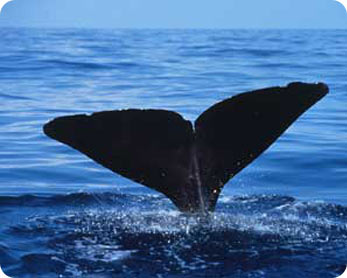Sperm whales may not make the most exciting sounds in the oceans, but their sounds have created some excitement among marine biologists in Europe. Recordings like these have shown that many more sperm whales ply the Mediterranean Sea near Italy than anyone had expected. What’s more, the recordings have revealed new details about how the whales behave and how they migrate.
 The fluke of Sperm Whale as it begins a dive into the Gulf of Mexico. Credit: National Marine Fishery Service
The fluke of Sperm Whale as it begins a dive into the Gulf of Mexico. Credit: National Marine Fishery ServiceSound is a new tool in the effort to study what’s happening in the ocean depths. Below depths of a few thousand feet, there’s no light at all. Even with spotlights, you can’t see very far. But sound travels quite well in water -- it can carry for miles. And improvements in technology are allowing scientists to monitor sounds at depths of a mile or two -- something that hasn’t been possible until recently.
A new network of underwater listening stations is tuning in. It’s called Listening to the Deep Ocean. It’s already hooked up stations from the Mediterranean to the Arctic Ocean, and from Japan to California.
The deep-sea microphones will allow scientists to learn more about whales, dolphins, and other marine life... and to listen for the underwater earthquakes that can trigger tsunamis. It’ll also let them hear the sounds created by people -- sounds like boat propellers and sonar. Such sounds could make it harder for marine life to survive in the increasingly noisy realm of the deep oceans.

